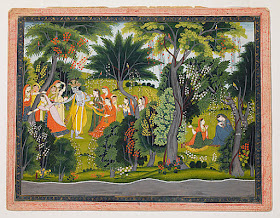Exploring the intersection of indigenous visual art and the Gospel of Jesus Christ.
Sunday, March 25, 2012
Nyoman Darsane at The Jesus Question
Wednesday, March 21, 2012
Christian Art Worldwide by Laurel Gasque
 |
| The Annunciation, door carving by Bandele of Osi-Ilorin, 1964. |
Here's a great article from 1995 by Laurel Gasque about nonwestern Christian visual art (at least at that time). In it she gives a good overview of the shift of Christiandom from the west to the east, and how this is reflected in a growing body of Christian visual arts from around the globe.
One especially helpful insight is the paragraph in which she mentions Nathan Corbitt's four classifications of contemporary Christian art, based on its purpose: liturgical art, functional art, professional art and mission art. Gasque writes, "Knowing the intent of the artist and the function (i.e., action) of a particular work of art aids us considerably in accounting for its form and content, even at times its quality." These four categories are helpful also when analyzing indigenous visual art forms, in order to determine their possible application to a Christian context such as evangelism, worship, or discipleship (of an artist, or of others through the use of contextualized art forms).
Tuesday, March 6, 2012
Art as Culture: An Introduction to the Anthropology of Art
Since teaching for a week last September on analyzing visual arts at GIAL, I've wanted to find a book that describes the role of visual arts in indigenous cultures from an anthropological perspective. That is, a book that explains the purpose of visual artifacts in traditional/nonwestern cultures– why they were created at all and how such cultures "use" and perceive them. Ultimately, why these artifacts were created at all.
In addition, a book that also explains how to identify these artifacts (harder than it sounds– what is art, anyway?) and how to describe/analyze them.
I used a couple of books (here and here) in the class that offered collections of writings by various authors on one aspect of the topic or another, but none which gave a comprehensive understanding. I recently ordered a couple of similar texts (here and here), which I've just begun to peruse.
But I think I may have finally found the book that comes closest: Art as Culture: An Introduction to the Anthropology of Art by Evelyn Payne Hatcher. I hope this is the one, if for no other reason because it's becoming an expensive quest! Once I've read it I'll share my thoughts here. One reviewer writes,
It looks to be a good read, for someone like me at least!
In addition, a book that also explains how to identify these artifacts (harder than it sounds– what is art, anyway?) and how to describe/analyze them.
I used a couple of books (here and here) in the class that offered collections of writings by various authors on one aspect of the topic or another, but none which gave a comprehensive understanding. I recently ordered a couple of similar texts (here and here), which I've just begun to peruse.
But I think I may have finally found the book that comes closest: Art as Culture: An Introduction to the Anthropology of Art by Evelyn Payne Hatcher. I hope this is the one, if for no other reason because it's becoming an expensive quest! Once I've read it I'll share my thoughts here. One reviewer writes,
Hatcher's background and research in both anthropology and art give her a command of a broad view nowhere else offered in the literature. Hers is the only book in the anthropology of art that covers all the major well-known tribal art styles, juxtaposes them with the arts of civilizations usually left to art historians, and introduces the reader to a full range of theoretical approaches to interpretation. While Hatcher's scholarly, thorough presentation of familiar styles provides many fresh insights, her theoretical stance is reassuringly familiar and solidly anthropological: the arts are understood comparatively, in context, and in all their complexity; in short, as culture.
It looks to be a good read, for someone like me at least!
Saturday, March 3, 2012
A Brief History of Visual Contextualization in India: Hindu Art
 |
| Krishna Flirting with the Gopis, c. 1780–1820 |
As I stated in my last post in this series, both Hindu and Buddhist art in India grew indirectly out the Indus Valley/Harrapan civilization (3300–1300 BC), with each religion developing its own styles and subject matter. Buddhist art came to prominence first, around the first century BC, and continued to be prominent in India through the 16th century AD.

